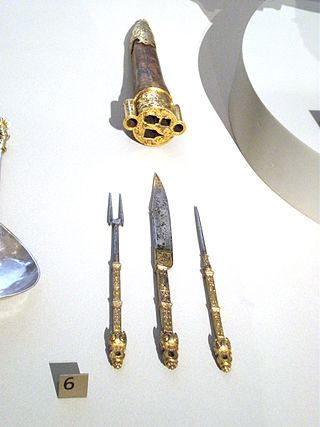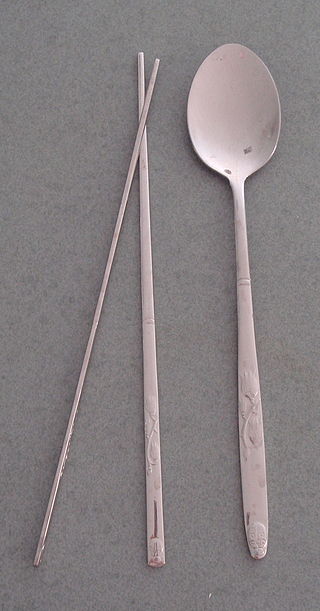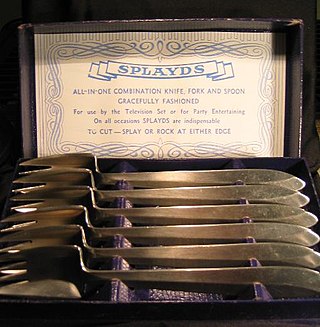This is a list of serving utensils .
- Knives
- Spoons
- Miscellaneous
- Tritensil
- Spifork
- Chork
- Forkchops
- Pizza Fork
- Bombilla
- FRED(Field Ration Eating Device)
- Toffee hammer
- Tongs
- Luncheon knife
- Grapefruit knife
This is a list of serving utensils .
scraper

A tablespoon is a large spoon. In many English-speaking regions, the term now refers to a large spoon used for serving; however, in some regions, it is the largest type of spoon used for eating.

A spoon is a utensil consisting of a shallow bowl, oval or round, at the end of a handle. A type of cutlery, especially as part of a place setting, it is used primarily for transferring food to the mouth. Spoons are also used in food preparation to measure, mix, stir and toss ingredients and for serving food. Present day spoons are made from metal, wood, porcelain or plastic. There are a wide variety of spoons that are made of a variety of materials and by different cultures for many different uses and foods.

In cutlery or kitchenware, a fork is a utensil, now usually made of metal, whose long handle terminates in a head that branches into several narrow and often slightly curved tines with which one can spear foods either to hold them to cut with a knife or to lift them to the mouth.

A spork is a form of cutlery and combination utensil taking the form of a spoon-like scoop with two to four fork-like tines. Spork-like utensils, such as the terrapin fork or ice cream fork, have been manufactured since the late 19th century; patents for spork-like designs date back to at least 1874. Sporks are commonly used by fast food restaurants, schools, prisons, militaries, backpackers, and airlines.

Cutlery, includes any hand implement used in preparing, serving, and especially eating food in Western culture. A person who makes or sells cutlery is called a cutler. The city of Sheffield in England has been famous for the production of cutlery since the 17th century and a train – the Master Cutler – running from Sheffield to London was named after the industry. Bringing affordable cutlery to the masses, stainless steel was developed in Sheffield in the early 20th century.

Table setting or place setting refers to the way to set a table with tableware—such as eating utensils and for serving and eating. The arrangement for a single diner is called a place setting. It is also the layout in which the utensils and ornaments are positioned. The practice of dictating the precise arrangement of tableware has varied across cultures and historical periods.

Various customary etiquette practices exist regarding the placement and use of eating utensils in social settings. These practices vary from culture to culture. Fork etiquette, for example, differs in Europe, the United States, and Southeast Asia, and continues to change. In East Asian cultures, a variety of etiquette practices govern the use of chopsticks.

Kitchenware are the tools, utensils, appliances, dishes, and cookware used in food preparation, or the serving of food. Kitchenware can also be used in order to hold or store food before or after preparation.

Tableware items are the dishware and utensils used for setting a table, serving food, and dining. The term includes cutlery, glassware, serving dishes, serving utensils, and other items used for practical as well as decorative purposes. The quality, nature, variety and number of objects varies according to culture, religion, number of diners, cuisine and occasion. For example, Middle Eastern, Indian or Polynesian food culture and cuisine sometimes limits tableware to serving dishes, using bread or leaves as individual plates, and not infrequently without use of cutlery. Special occasions are usually reflected in higher quality tableware.

Sujeo (수저) is the Korean word for the set of eating utensils commonly used to eat Korean cuisine. The word is a portmanteau of the words sutgarak and jeotgarak. The sujeo set includes a pair of oval-shaped or rounded-rectangular metal chopsticks, and a long handled shallow spoon of the same material. One may use both at the same time, but this is a recent way to eat quicker. It is not considered good etiquette to hold the spoon and the chopstick together in one hand especially while eating with elders. More often food is eaten with chopsticks alone. Sometimes the spoon apart from chopsticks is referred to as sujeo.

A splayd is an eating utensil combining the functions of spoon, knife and fork. It was invented by William McArthur in the 1940s in Sydney, New South Wales, Australia. There are several manufacturers.

Table manners are the rules of etiquette used while eating, which may also include the use of utensils. Different cultures observe different rules for table manners. Each family or group sets its own standards for how strictly these rules are to be followed.
The Montreal–Philippines cutlery controversy was an incident in 2006 in which a Filipino-born Canadian boy was punished by his school in Roxboro, Montreal, for following traditional Filipino etiquette and eating his lunch with a fork and a spoon, rather than the Canadian tradition of a knife and fork.

A kitchen utensil is a small hand-held tool used for food preparation. Common kitchen tasks include cutting food items to size, heating food on an open fire or on a stove, baking, grinding, mixing, blending, and measuring; different utensils are made for each task. A general purpose utensil such as a chef's knife may be used for a variety of foods; other kitchen utensils are highly specialized and may be used only in connection with preparation of a particular type of food, such as an egg separator or an apple corer. Some specialized utensils are used when an operation is to be repeated many times, or when the cook has limited dexterity or mobility. The number of utensils in a household kitchen varies with time and the style of cooking.

Chopsticks are shaped pairs of equal-length sticks that have been used as kitchen and eating utensils in most of East and Southeast Asia for over three millennia. They are held in the dominant hand, secured by fingers, and wielded as extensions of the hand, to pick up food.

A steak knife is a sharp table knife designed to efficiently and effectively cut steak. This type of knife comes in a variety of styles and sizes; however, the design often used in a steakhouse typically features a partially serrated blade and wood handle.

Edible tableware is tableware, such as plates, drinkware glasses, utensils and cutlery, that is edible. Edible tableware can be homemade and has also been mass-produced by some companies, and can be prepared using many various foods.

Combination eating utensils, also known as hybrid utensils, are utensils that have the qualities of other utensils combined into one. This can be done to make a more convenient, less wasteful, or more cost-efficient product. Many different types of combination utensils have been created, each designed to serve a different purpose.